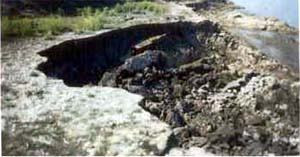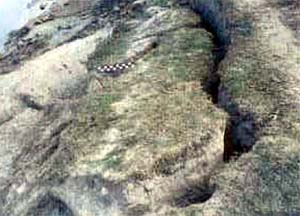Nov 28, 2025
Nov 28, 2025
Ancient explorers who founded Praagjyotishpur in Kamrup district must have discerned something special about this river, that is why they gave it a masculine name (Brahma=Hindu god, Putra=Son) says K.S. Valdiya, a renowned earth-scientist and teacher. Like an untamed son this river continues to play havoc in northeastern region every year. Why the river gets more flooded than many of its counterparts in India? Why does it erode its banks with vengeance? Can it be tamed? These are some questions that plague the minds of those who face Brahmaputra's fury. Here lies the catch; The Eastern Himalayas take almost a 'knee-bend' at their extreme northeastern end. This bend is called the Himalayan Syntaxis by the geologists, a product of the massive collision between the Indian, Tibetan and Indo-Myanmar plates. There is severe deformation of the Himalayas caught in this tight corner and consequently there is lots of faulting and thrusting in the part caught between the Himalaya-Patkai Naga ranges and the Meghalaya massif. This is a part of the country where the Indian Peninsular shield is nearest to the Himalayas. Obviously the river had to carve a path through a terrain that is tectonically active even now. The Meghalaya massif acts as a pivot around which the River Brahmaputra flows from east to west then north to south and then again from west to east and finally turns southwards from near Dhaka in Bangladesh.
Despite building 3647 km of embankments, 599 km of drainage channels and 431 sq km area of soil conservation Brahmaputra continues to wreck havoc year after year says Valdiya. Catastrophic floods have occured in 1954, 1962, 1966, 1972, 1973, 1977, 1978, 1983, 1984, 1987, 1988, 1991, 1993, 1995, 1996 and 1998. Upwards of 9600 sq km land, that is 12.21% of the geographic area of Assam, is annually affected by floods. In 1998, the flood which came in four frightening waves, deluged 38,200 sq km or 48.65% geographic area of the state, putting in peril the lives and properties of 15 million people.
It is a grim scenario indeed. Geologists call Brahmaputra valley as a tectono-sedimentary valley. That is a valley formed due to tectonic processes or the forces acting from within the depths of the earth, rather than simple erosional valley. The northeastern region is geo-dynamically restless. In front of the fury of the nature here in the northeast, the ruler of the earth, the man finds himself a puny little creature. The engineering structures to tame a river in such conditions prove useless.
Brahmaputra is the fourth largest river in terms of average discharge at the mouth, and second in terms of sediment transport per unit drainage area in the world. Despite its might compared to 300-350 km wide Sindhu and Ganga plains, the Brahmaputra plains are less than 100 km wide. Why the river is sort of stifled in its own regime?
Precision surveys by the Survey of India (SOI) indicate that parts of blocks of the Guwahati-Dergaon section have been steadily risen steadily and vertically from 0.3 mm/yr to 4.5 to 31mm/yr at Dergaon. This implies that the Mikir block is rising at a faster rate says Valdiya. Similarly Meghalaya block has been rising in some parts at a rate of 0.3 to 0.4 mm/yr. The gorge that Brahmaputra has cut near Guwahati gives credence to the rising Meghalaya block theory of Valdiya. The river otherwise, flows through a wide valley.
The rising Meghalaya block must have, once upon a time ponded the Brahmaputra River conjectures Valdiya. Later even after the blockade was removed the continuous movement of the block reduced the load carrying capacity of the stream. These sediments got deposited in the stream as islands and bars. These landforms have further reduced the carrying capacity of the river says Valdiya.
One can visualize the enormity of the Brahmaputra by the fact that one of the islands Majuli had an area of 1858 square miles in 1901. By 1990 much of the land had been eroded off and the left over area was only 514 sq km. It is world's largest populated river island, with a population of 2.15 lakh people. The island is rich with biodiversity and a tourist's paradise too. Majuli is facing threat of erosion and the life of people, fauna and the flora is at stake. R.D. Oldham, the founder of seismology, while studying the impact of Great Assam Earthquake (1897) wrote in his memoir that the earthquake also caused ponding of the river, as there was a huge deluge unrelated to rainfall.
It is the rapid erosion by the Brahmaputra that is becoming a matter of concern. Floods are an annual feature and are dependent to quite an extent on the precipitation. But the erosion is continuous process. P. Kotoky, D. Bezbaruah and J. Baruah of Geoscience Division, Regional Research Laboratory, Jorhat and J.N. Sarma of Dibrugarh University tried to find out causes of extensive erosion by the River and published their findings in the Current Science (February, 2005).
They chose a 270 km long stretch of Brahmaputra channel from Panidihing Reserve Forest to Haloukonda Bil. This stretch covers the 'Majuli' Island and also the Kaziranga National Park the habitat of endangered Indian Rhino. They found that the activity of erosion and deposition of sediments was not similar during the periods 1914-1975 and 1975 to 1998. They studied the past erosional activities with the help of Survey Of India Maps. Maximum erosion took place during the period 1914-75. Though deposition of sediments also took place on the south bank of the river to the tune of 28.15 sq km and 38.75 sq km near Sikarighat and Bhomoraguri Hills respectively. The area between Jorhat-Majuli to Kumargaon faces maximum erosion. In this 50 km long track a total of 49.5 sq km land has been lost due to erosion. Similarly around Kaziranga National Park and area of 83.43 sq km area had been eroded off till 1975 say Kotoky and his co-workers. During the period 1975 to 1998 a shift in pattern of erosion was observed by these workers. There has been a slight reduction in erosion around Majuli. In the area of Kaziranga near the confluence of Burai river with Brahmaputra an area of 17.65 sq km was added on the southern side due to deposition by the river.
 Brahmaputra reaches northeastern part of our country after traveling long distances in China. Thus the River carries an assortment of sediments. The material carried by the river in in-homogenous. The same material when deposited by the river on its banks causes differential compaction layer after layer. During floods all pore spaces between sediment grains are filled up with water. They are all held in place. As soon as flood waters withdraw, matter with higher porosity collapses as the binding material (water) is withdrawn. This results in to collapse of chunks of the bank. The swift flowing river never misses and carries off such parts of the bank.
Brahmaputra reaches northeastern part of our country after traveling long distances in China. Thus the River carries an assortment of sediments. The material carried by the river in in-homogenous. The same material when deposited by the river on its banks causes differential compaction layer after layer. During floods all pore spaces between sediment grains are filled up with water. They are all held in place. As soon as flood waters withdraw, matter with higher porosity collapses as the binding material (water) is withdrawn. This results in to collapse of chunks of the bank. The swift flowing river never misses and carries off such parts of the bank.
https://www.boloji.com/articlephotos/Fury of Brahmaputra.jpg Saturation of material with water and then sudden drying is thus one of the most common causes of bank failure. This is quite frequent near the western tip of Majuli and upstream of Nematighat, say Kotoky et al.
Saturation of material with water and then sudden drying is thus one of the most common causes of bank failure. This is quite frequent near the western tip of Majuli and upstream of Nematighat, say Kotoky et al.
Parts of banks where walls are steep are prone to fluvial erosion. Softer material of the bank walls under water is scoured off and the heavier more compact sediments at the top collapse causing large chunks of bank to fall and lost in the river. In some localities of Kaziranga National Park where clayey sediments dominate, during summer heat hexagonal cracks are formed on the surface. During peak summer these are deepened and the weak planes thus formed vertically down become prone to collapse when the River is in spate during the ensuing monsoon. These cracks are therefore 'preparatory' processes for the erosion by the River.
In some localities of Kaziranga National Park where clayey sediments dominate, during summer heat hexagonal cracks are formed on the surface. During peak summer these are deepened and the weak planes thus formed vertically down become prone to collapse when the River is in spate during the ensuing monsoon. These cracks are therefore 'preparatory' processes for the erosion by the River.
A mighty river, with channel activated by subterranean forces, swift currents due to gradient, assorted nature of bank forming sediments all need a special treatment. Building of embankments and drainage channels in upper Assam would not bring relief from flood hazard says Valdiya. In order to channelize the discharge of the mighty Brahmaputra he recommends a network of canals, aqueducts and tunnels etc. across the northward prolongation of the Meghalaya block particularly between Guwahati and Hathimura. This is the area where active faults cross the channel of the River. The canals will have to periodically deepened to keep pace with the rate of uplift of the block. The problem would be eased only by engineering structure that does not allow ponding of the river channel are constructed. Ponding leads to deposition of sediments and reduces the carrying capacity of the stream.
Brahmaputra river is a unique river system which flows through a seismically active terrain hence before harnessing the river for its hydro-electric power; it would be prudent to channelize the river through solutions recommended by the geologists. Else the might of the river is such that it is capable of sweeping away any obstacle (read power project) that comes in its wake!
02-Mar-2008
More by : V. K. Joshi (Bijji)